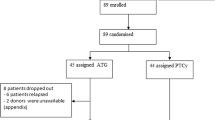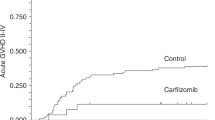Abstract
Relapse after dose-reduced allograft in advanced myeloma patients remains high. To reduce the risk of relapse, we investigated a myeloablative toxicity-reduced allograft (aSCT) consisting of i.v. BU and CY followed by lenalidomide maintenance therapy in 33 patients with multiple myeloma (MM) who relapsed following an autograft after a median of 12 months. The cumulative incidence of non-relapse mortality at 1 year was 6% (95% confidence interval (CI): 0–14). After a median interval of 168 days following aSCT, 24 patients started with a median dose of 5 mg (r, 5–15) lenalidomide without dexamethasone. During follow-up, 13 patients discontinued lenalidomide owing to progressive disease (n=6), GvHD (n=3), thrombocytopenia (n=2), or fatigue (n=2). Major toxicities of lenalidomide were GvHD II–III (28%), viral reactivation (16%), thrombocytopenia (III–IV°,16%), neutropenia (III/IV°, 8%), peripheral neuropathy (I/II°, 16%), or other infectious complication (8%). Cumulative incidence of relapse at 3 years was 42% (95% CI: 18–66). The 3-year estimated probability of PFS and OS was 52% (95% CI: 28–76) and 79% (95% CI: 63–95), respectively. Toxicity-reduced myeloablative allograft followed by lenalidomide maintenance is feasible and effective in relapsed patients with MM, but the induction of GvHD should be considered.
This is a preview of subscription content, access via your institution
Access options
Subscribe to this journal
Receive 12 print issues and online access
$259.00 per year
only $21.58 per issue
Buy this article
- Purchase on Springer Link
- Instant access to full article PDF
Prices may be subject to local taxes which are calculated during checkout


Similar content being viewed by others
References
Badros A, Barlogie B, Siegel E, Cottler-Fox M, Zangari M, Fassas A et al. Improved outcome of allogeneic transplantation in high-risk multiple myeloma patients after nonmyeloablative conditioning. J Clin Oncol 2002; 20: 1295–1303.
Giralt S, Aleman A, Anagnostopoulos A, Weber D, Khouri I, Anderlini P et al. Fludarabine/melphalan conditioning for allogeneic transplantation in patients with multiple myeloma. Bone Marrow Transplant 2002; 30: 367–373.
Einsele H, Schäfer HJ, Hebart H, Liebisch P, Bamberg M, Faul C et al. Follow-up of patients with progressive multiple myeloma undergoing allografts after reduced-intensity conditioning. Br J Haematol 2003; 121: 411–418.
Lee CK, Badros A, Barlogie B, Morris C, Zangari M, Fassas A et al. Prognostic factors in allogemeic transplantation for patients with high-risk multiple myeloma after reduced intensity conditioning. Exp Hematol 2003; 31: 73–80.
Shaw BE, Peggs K, Bird JM, Cavenagh J, Hunter A, Madrigal A . for the Clinical Trials Committee of the British Society of Blood and Marrow Transplantation The outcome of unrelated donor stem cell transplantation for patients with multiple myeloma. Br J Haematol 2003; 123: 886–895.
Peggs KS, Mackinnon S, Williams CD, D’Sa S, Thuraisundaram D, Kyriakou C et al. Reduced-intensity transplantation with in vivo T-cell depletion and adjuvant dose-escalating donor lymphocyte infusions for chemotherapy-sensitive myeloma: Limited efficacy of graft-versus-tumor activity. Biol Blood Marrow Transplant 2003; 9: 257–265.
Kröger N, Perez-Simon JA, Myint H, Klingemann H, Shimoni A, Nagler A et al. Relapse to prior autograft and chronic graft-versus-host disease are the strongest prognostic factors for outcome of Melphalan/fludarabine-based dose-reduced allogeneic stem cell transplantation in patients with multiple myeloma. Biol. Blood Marrow Transplantat 2004; 10: 698–708.
Kröger N, Shimoni A, Schilling G, Schwerdtfeger R, Bornhäuser M, Nagler A et al. Unrelated stem cell transplantation after reduced intensity conditioning for patients with multiple myeloma relapsing after autologous transplantation. Br J Haematol 2010; 148: 323–331.
Crawley C, Lalancette M, Szydlo R, Gilleece M, Peggs K, Mackinnon S et alChronic Leukaemia Working Party of the EBMT Outcomes for reduced-intensity allogeneic transplantation for multiple myeloma: an analysis of prognostic factors from the Chronic Leukemia Working Party of the EBMT. Blood 2005; 105: 4532–4539.
Kröger N . Mini-Midi-Maxi? How to harness the graft-versus-myeloma effect and target molecular remission after allogeneic stem cell transplantation. Leukemia 2007; 21: 1851–1858.
Gahrton G, Svenson H, Cavo M, Apperly J, Bacigalupo A, Björkstrand B et alEuropean Group for Blood and Marrow Transplantation Progress in allogeneic bone marrow and peripheral blood stem cell transplantation for multiple myeloma: a comparison between transplants performed 1983-93 and 1994-98 at European Group for Blood and Marrow Transplantation centres. Br J Haematol 2001; 113: 209–216.
Attal M, Lawers V, Marit G et al. Maintenance treatment with lenalidomide after transplantation for myeloma: final analysis of the IFM 2005-02 [abstract]. ASH Annual Meeting Abstracts 2010; 116: 310.
McCarthy PL, Owzar K, Anderson KC, Hofmeister CC, Hassoun H, Hurd DD et al. Phase III intergroup study of lenalidomide versus placebo maintenance therapy following single autologous hematopoietic stem cell transplantation (AHSCT) for multiple myeloma: CALGB 100104 [abstract]. ASH Annual Meeting Abstracts 2010; 116: 37.
Przepiorka D, Weisdorf D, Martin P, Klingemann HG, Beatty P, Hows J et al. Consensus conference on acute GVHD grading. Bone Marrow Transplant 1995; 15: 825–828.
Bladé J, Samson D, Reece D, Apperley J, Björkstrand B, Gahrton G et al. Criteria for evaluating disease response and progression in patients with multiple myeloma treated by high-dose therapy and haemopoietic stem cell transplantation. Myeloma Subcommittee of the EBMT. European Group for Blood and Marrow Transplantation. Br J Haematol 1998; 102: 1115–1123.
Weber DM, Chen C, Niesvizky R, Wang M, Belch A, Stadtmauer EA et al. Multiple Myeloma (009) Study Investigators. Lenalidomide plus dexamethasone for relapsed multiple myeloma in North America. N Engl J Med 2007; 357: 2133–2142.
Richardson PG, Sonneveld P, Schuster M, Irwin D, Stadtmauer E, Facon T et al. Extended follow-up of a phase 3 trial in relapsed multiple myeloma: final time-to-event results of the APEX trial. Blood 2007; 110: 3557–3560.
Dimopoulos M, Spencer A, Attal M, Prince HM, Harousseau JL, Dmoszynska A et al. Multiple Myeloma (010) Study Investigators. Lenalidomide plus dexamethasone for relapsed or refractory multiple myeloma. N Engl J Med 2007; 357: 2123–2132.
Kropff M, Bisping G, Schick E, Liebisch P, Lang N, Hentrich M et al. Deutsche Studiengruppe Multiples Myelom. Bortezomib in combination with intermediate-dose dexamethsone and continous low-dose oral cyclophosphamide for relapsed multiple myeloma. Br J Haematol 2007; 138: 330–337.
Pönisch W, Rozanski M, Goldschmidt H, Hoffmann FA, Boldt T, Schwarzer A et alEast German Study Group of Hematology and Oncology (OSHO) Combined bendamustine, prednisolone and thalidomide for refractory or relapsed multiple myeloma after autologous stem-cell transplantation or conventional chemotherapy: results of a PHASE I clinical trial. Br J Haematol 2008; 143: 191–200.
De Lavallade H, El-Cheikh J, Faucher C, Fürst S, Stoppa AM, Coso D et al. Reduced-intensity conditioning allogeneic SCT as a salvage treatment for relapsed multiple myeloma. Bone Marrow Transplant 2008; 41: 953–960.
Kashyap A, Wingard J, Cagnoni P, Roy J, Tarantolo S, Hu W, Blume K et al. Intravenous versus oral busulfan as part of a busulfan/cyclophosphamide preparative regimen for allogeneic hematopoietic stem cell transplantation: decreased incidence of hepatic veno-occlusive disease (HVOD), HVOD-related mortality, and overall 100-day mortality. Biol Blood Marrow Transplant 2002; 8: 493–500.
De Lima M, Couriel D, Thall PF, Wang X, Madden T, Jones R et al. Once-daily intravenous busulfan and fludarabine: clinical and pharmacokinetic results of a myeloablative, reduced-toxicity conditioning regimen for allogeneic stem cell transplantation in AML and MDS. Blood 2004; 104: 857–864.
Kröger N, Einsele H, Derigs G, Wandt H, Krüll A, Zander AR . Long-term follow-up of an intensified myeloablative conditioning regimen with in vivo T cell depletion followed by allografting in patients with advanced multiple myeloma. Biol Blood Marrow Transplant 2010; 16: 861–864.
Wolschke C, Stübig T, Schonland S, Hegenbart U, Atanackovic D, Dreger P et al. Dose-finding study of lenalidomide as maintenance therapy in multiple myeloma after allogeneic stem cell transplantation. Blood 2010; 116 (Abstract): 2376.
Georges GE, Maris MB, Maloney DG, Sandmaier BM, Sorror ML, Shizuru JA et al. Nonmyeloablative unrelated donor hematopoietic cell transplantation to treat patients with poor-risk, relapsed, or refractory multiple myeloma. Biol Blood Marrow Transplant 2007; 13: 423–432.
Kneppers E, van der Holt B, Kersten MJ, Zweegman S, Meijer E, Huls G et al. Lenalidomide maintenance following non-myeloablative allogeneic stem cell transplantation in multiple myeloma is not feasible: results of the HOVON 76 trial. Blood 2011; 118: 2413–2419.
Acknowledgements
NK received research funding from Celgene. MK and GS received honorarium from Celgene.
Author information
Authors and Affiliations
Corresponding author
Ethics declarations
Competing interests
The authors declare no conflict of interest.
Rights and permissions
About this article
Cite this article
Kröger, N., Zabelina, T., Klyuchnikov, E. et al. Toxicity-reduced, myeloablative allograft followed by lenalidomide maintenance as salvage therapy for refractory/relapsed myeloma patients. Bone Marrow Transplant 48, 403–407 (2013). https://doi.org/10.1038/bmt.2012.142
Received:
Revised:
Accepted:
Published:
Issue Date:
DOI: https://doi.org/10.1038/bmt.2012.142
Keywords
This article is cited by
-
Mogamulizumab for post-transplant relapse of adult T-cell leukemia/lymphoma: a case study
International Journal of Hematology (2023)
-
Maintenance therapy after allogeneic hematopoietic stem cell transplantation for patients with multiple myeloma
International Journal of Hematology (2023)
-
Current Role of Allogeneic Stem Cell Transplantation in Multiple Myeloma
Oncology and Therapy (2022)
-
Evaluation of EuroFlow minimal residual disease measurement and donor chimerism monitoring following tandem auto-allogeneic transplantation for multiple myeloma
Bone Marrow Transplantation (2021)
-
Long-term outcome after allogeneic stem cell transplantation in multiple myeloma
Annals of Hematology (2021)



